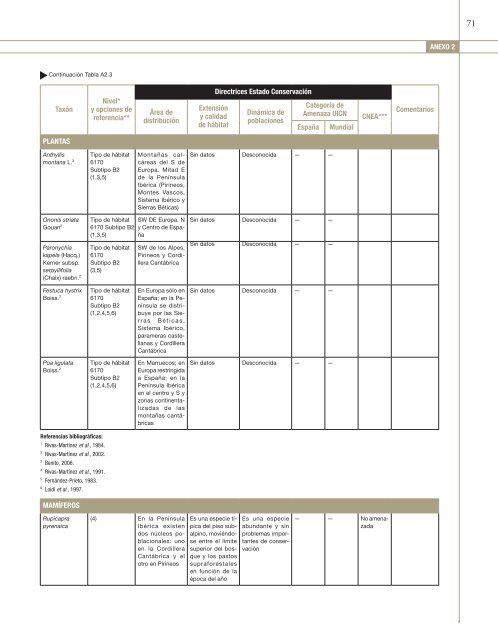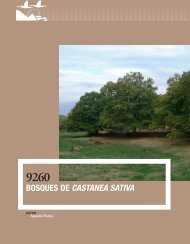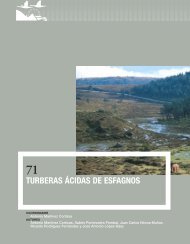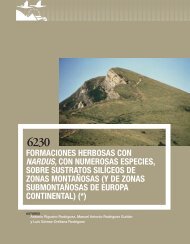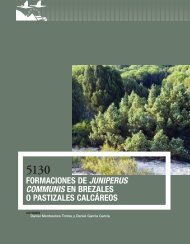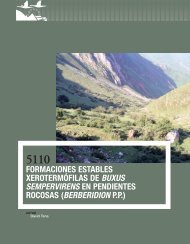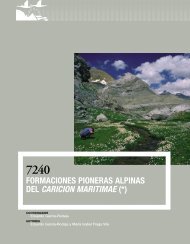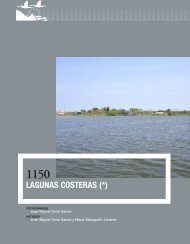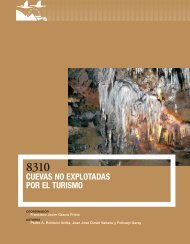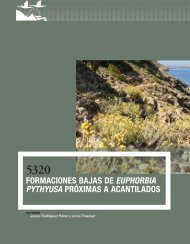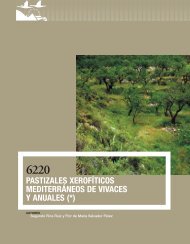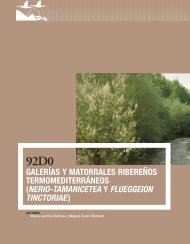6170 Pastos de alta montaña caliza - Jolube
6170 Pastos de alta montaña caliza - Jolube
6170 Pastos de alta montaña caliza - Jolube
Create successful ePaper yourself
Turn your PDF publications into a flip-book with our unique Google optimized e-Paper software.
Continuación Tabla A2.3<br />
taxón<br />
plantas<br />
Anthyllis<br />
montana L. 2<br />
Ononis striata<br />
Gouan 2<br />
Paronychia<br />
kapela (Hacq.)<br />
Kerner subsp.<br />
serpyllifolia<br />
(Chaix) raebn. 2<br />
Festuca hystrix<br />
Boiss. 2<br />
Poa ligulata<br />
Boiss. 2<br />
referencias bibliográficas:<br />
1<br />
Rivas-Martínez et al., 1984.<br />
2 Rivas-Martínez et al., 2002.<br />
3 Benito, 2006.<br />
4 Rivas-Martínez et al., 1991.<br />
5<br />
Fernán<strong>de</strong>z-Prieto, 1983.<br />
6<br />
Loidi et al., 1997.<br />
mamíferos<br />
Rupicapra<br />
pyrenaica<br />
nivel*<br />
y opciones <strong>de</strong><br />
referencia**<br />
Tipo <strong>de</strong> hábitat<br />
<strong>6170</strong><br />
Subtipo B2<br />
(1,3,5)<br />
Área <strong>de</strong><br />
distribución<br />
Montañas calcáreas<br />
<strong>de</strong>l S <strong>de</strong><br />
Europa. Mitad E<br />
<strong>de</strong> la Península<br />
Ibérica (Pirineos,<br />
Montes Vascos,<br />
Sistema Ibérico y<br />
Sierras Béticas)<br />
Tipo <strong>de</strong> hábitat SW DE Europa. N<br />
<strong>6170</strong> Subtipo B2 y Centro <strong>de</strong> Espa-<br />
(1,3,5)<br />
ña<br />
Tipo <strong>de</strong> hábitat<br />
<strong>6170</strong><br />
Subtipo B2<br />
(3,5)<br />
Tipo <strong>de</strong> hábitat<br />
<strong>6170</strong><br />
Subtipo B2<br />
(1,2,4,5,6)<br />
Tipo <strong>de</strong> hábitat<br />
<strong>6170</strong><br />
Subtipo B2<br />
(1,2,4,5,6)<br />
SW <strong>de</strong> los Alpes,<br />
Pirineos y Cordillera<br />
Cantábrica<br />
En Europa sólo en<br />
España; en la Península<br />
se distribuye<br />
por las Sier<br />
r a s B é t i c a s ,<br />
Sistema Ibérico,<br />
parameras castellanas<br />
y Cordillera<br />
Cantábrica<br />
En Marruecos; en<br />
Europa restringida<br />
a España; en la<br />
Península Ibérica<br />
en el centro y S y<br />
zonas continentalizadas<br />
<strong>de</strong> las<br />
<strong>montaña</strong>s cantábricas<br />
(4) En la Península<br />
Ibérica existen<br />
dos núcleos poblacionales:<br />
uno<br />
en la Cordillera<br />
Cantábrica y el<br />
otro en Pirineos<br />
extensión<br />
y calidad<br />
<strong>de</strong> hábitat<br />
directrices estado conservación<br />
dinámica <strong>de</strong><br />
poblaciones<br />
categoría <strong>de</strong><br />
amenaza Uicn cnea***<br />
españa mundial<br />
Sin datos Desconocida — —<br />
Sin datos Desconocida — —<br />
Sin datos Desconocida — —<br />
Sin datos Desconocida — —<br />
Sin datos Desconocida — —<br />
Es una especie típica<br />
<strong>de</strong>l piso subalpino,moviéndose<br />
entre el límite<br />
superior <strong>de</strong>l bosque<br />
y los pastos<br />
supraforestales<br />
en función <strong>de</strong> la<br />
época <strong>de</strong>l año<br />
Es una especie<br />
abundante y sin<br />
problemas importantes<br />
<strong>de</strong> conservación<br />
— — No amenazada<br />
comentarios<br />
anexo 2<br />
71


